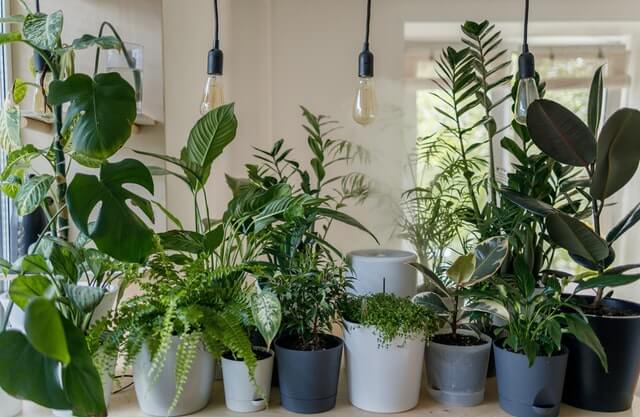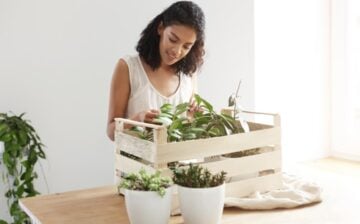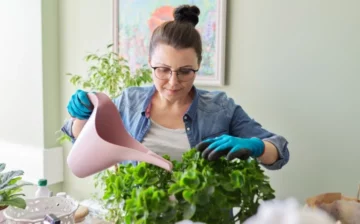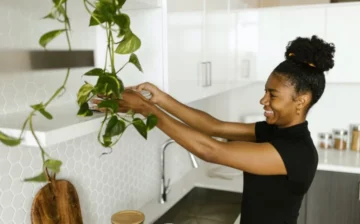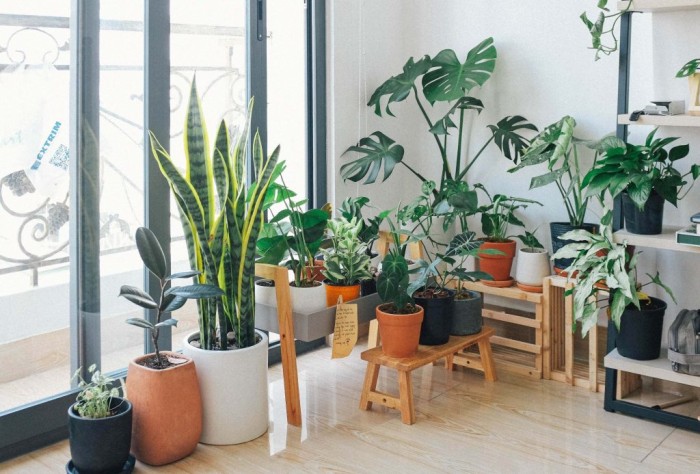
Indoor plants are an ideal option for those people with little yard space or those who live in cold climates. Our guide will give you the information you need to care for your indoor plants successfully.
Give Your Plants the Correct Amount of Light
Plants require light for energy photosynthesis. However, the amounts of light that indoor plants need vary. Apart from succulents such as desert cacti, most indoor plants require indirect light instead of direct light.
Plants that grow well in indirect light should be placed near the window. Those that need bright light and not direct sun should be placed a few feet from the window. Some indoor plants like succulents also require artificial light to grow especially if you live in places with fewer light hours.
Generally, regular light lamps aren’t effective in providing light to indoor plants. So you will have to buy LED or fluorescent grow lights. These lamps have full-spectrum light that balances warm and cool light which mimics the natural solar spectrum.
Water Your Houseplants Regularly
While it’s important to water your plants, you should avoid under-watering or over-watering. Most indoor plants grow better when they are slightly dry than when extremely wet. This is because they aren’t exposed to the direct sun that evaporates water quickly.
You should aim to supply your house plants with adequate water that keeps the soil moist and not soggy. When watering, pour water into the potting soil slowly. However, succulents require regular soakings.
Houseplants should be watered twice a week and once in a while during the winter months. If you want to know whether your plants require water, stick one of your fingers 2 inches deep into the soil. If the soil is dry, then it’s likely your plants need to be watered.
Choose the Right Pot Size for Your Plants
When selecting a pot, consider its drainage capability, size, and material. Also, ensure the pot is proportional to your houseplant’s current size. Its diameter should be a few inches wider than the root mass of your plant.
If the plant outgrows the pot, transfer it into a larger pot. Keep in mind that if you begin growing your houseplant in a larger pot, its roots won’t absorb moisture fast enough. Instead, the moisture drains through the soil.
For example, terra cotta pots are bulky, while their porous design doesn’t allow them to hold water. On the other hand, their plastic pots are lightweight, making them suitable for use on wall shelves. So when picking your pot, ensure it has a drainage opening at the bottom.
Check Humidity and Temperature Levels
Most indoor plants grow well in temperatures about 10 degrees at night and between 65 and 75 degrees during daylight. Typically, houseplants require humidity levels similar to that of plants growing in natural conditions. Air plants such as the genus Tillandsia absorb water from the air.
On the other side, there are some plants with an ideal temperature between 65-90 degrees Fahrenheit such as Variegated String of Hearts, in case you’d like to grow one of them in the future you should also know exactly how to take care and grow a variegated String of Hearts which is really important if you want to keep them for a long time in your home.
So they require periodic misting using a spray bottle. For other indoor plants, condensation that remains on the leaves for an extended period can be harmful. That’s why appropriate ventilation and airflow is essential for healthy plants.
Alternatively, you can put a fan near your plants to help circulate so that excess moisture evaporates. It can also prevent the accumulation of dust on leaves.
Apply Fertilizer to Your Plants
If you want to end up with healthy houseplants, replenish the nutrients regularly in the potting soil. To achieve this, apply fertilizer to your plants once a month when they are flowering.
However, you should pause or decrease the fertilizer during the winter months because plants remain in a stagnant state. Remember these are basic guidelines. So some plants may require a specific fertilizer type or fertilizer routine.
Use the Correct Potting Soil
Quality soil can help plant roots grow optimally, as it provides the right balance of water absorption, aeration, and nutrition. Potting soil mixes include vermiculite, peat moss, perlite, and shredded pine bark.
Instead of buying generic potting soil, opt for soil that’s ideal for your indoor plants. For instance, succulents thrive well in porous, sandy soil while bromeliads and orchids grow best in fast-draining soil.
What To Consider When Choosing Houseplants
There are several things to check when picking indoor plants.
- Disease or Pests: It’s crucial to ensure the plants you are purchasing do not have disease or pests because you risk transferring the pests to other plants you may have. Some signs of plants with diseases include white dots, odor, and sticky residue on the stems and leaves.
- Healthy Roots: This is also important when selecting a plant. Although it’s not realistic to pull plants out of their pots to examine the roots, it can be done if the plant is small. Good roots are light in color and thick.
- Foliage: When it comes to foliage, it should be thick enough. In other words, you should not see through it.
How Much Light Do Houseplants Require?
Cacti and succulents require continuous daily light while plants with foliage require 8 hours of light every day. However, the amount depends on the indoor plants you are growing. So you should research the specific plants you want to grow to know the right amount of light.
How Do Houseplants Impact People’s Mood?
Indoor plants are popular because they provide health benefits. They have mood-boosting properties and can minimize physiological stress. The plants also purify the air by removing toxins and pollutants from the air.
Conclusion
We hope this post has provided you with useful tips to help you care for your houseplants, especially if you are growing them for the first time.
We hope you found this blog post How To Grow Plants Indoors, useful. Be sure to check out our post Why We Need Plants And How To Take Care Of Them for more great tips!
Have Experience in the Moving Industry? Want an Additional Income Stream? Work With All Around Moving!
Partner with us and we’ll help you profit. Click here to learn more.


